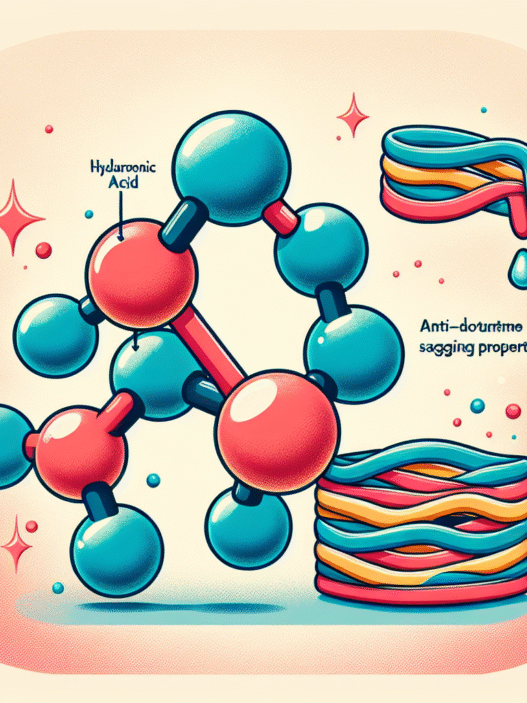Understanding Hyaluronic Acid
Hyaluronic acid is a key player in maintaining skin health and fighting the signs of aging. This naturally occurring glycosaminoglycan is found throughout the body, particularly in connective tissues. It plays a critical role in preserving skin moisture, reducing wrinkle appearance, and improving overall skin quality.
The Role of Hyaluronic Acid in Skin Health
Hyaluronic acid can help increase the moisture content in the skin, which is essential for maintaining elasticity and hydration. As individuals age, the production of hyaluronic acid in the body decreases by about 6% per decade. By the age of 50, our natural levels can be halved, contributing to skin slackening and wrinkling. Increasing hyaluronic acid levels through topical applications makes it easier to restore skin’s moisture balance.
Table 1 below summarizes the benefits of hyaluronic acid for skin health.
| Benefit | Description |
|---|---|
| Hydration | Increases moisture content, resulting in plump skin. |
| Wound Healing | Promotes the healing of damaged skin by aiding cell regeneration. |
| Elasticity | Helps maintain skin firmness and resilience against aging. |
Benefits of Hyaluronic Acid for Anti-Aging
Hyaluronic acid is celebrated for its notable anti-aging properties. It helps in reducing the appearance of fine lines and wrinkles by drawing moisture to the skin’s surface and ensuring it remains hydrated. This increased hydration is vital for maintaining a youthful glow and skin texture.
Research supports the effectiveness of hyaluronic acid in addressing skin aging. A 2019 study revealed that a combination of oral and topical hyaluronic acid improved symptoms related to dry skin, demonstrating its hydrating effects (Medical News Today).
Incorporating products that feature hyaluronic acid, like a hyaluronic acid serum or hyaluronic acid moisturizer, can help enhance the skin’s appearance over time. By addressing hydration, elasticity, and overall complexion, hyaluronic acid emerges as a powerful component in the fight against wrinkles and aging skin.
For those looking for more information on how this substance interacts with skincare, detailed insights on hyaluronic acid and collagen can provide further understanding.
Types and Molecular Weights of Hyaluronic Acid
Understanding the different types and molecular weights of hyaluronic acid is crucial for beauty and skincare enthusiasts who aim to combat wrinkles. The molecular weight significantly influences its effectiveness in hydrating and rejuvenating the skin.
Importance of Molecular Weight in Hyaluronic Acid
Molecular weight determines a substance’s ability to penetrate the skin barrier effectively. Hyaluronic acid (HA) can bind up to 1000 times its weight in water, acting as a humectant that retains moisture on the skin’s surface. Larger molecules, generally over 500 kDa, face limitations in penetrating the skin, while smaller molecules, under 500 kDa, demonstrate a better ability to penetrate and provide hydration.
The efficacy of hyaluronic acid, especially regarding its anti-aging properties and ability to hydrate skin thoroughly, relies heavily on selecting the appropriate molecular weight.
Low vs. High Molecular Weight Hyaluronic Acid
Hyaluronic acid can be categorized into low and high molecular weight variations, each serving different purposes within skincare.
| Molecular Weight Category | Size (kDa) | Benefits |
|---|---|---|
| Low Molecular Weight HA | 20 – 300 | Penetrates deeper layers of skin, stimulates cell proliferation, and enhances endogenous production of HA and type I collagen, contributing to hydration and regeneration. |
| High Molecular Weight HA | 1000 – 1400 | Forms a protective layer on the skin surface, reducing moisture loss while providing a plumping effect. It helps to restore tone, minimizing fine lines and wrinkles. |
Low molecular weight hyaluronic acid effectively reaches the stratum corneum and deeper skin layers, promoting hydration and improving skin structure (Filorga). On the other hand, high molecular weight hyaluronic acid primarily functions to protect and hydrate the surface of the skin (Filorga).
Choosing the right formulation makes a significant difference in how well hyaluronic acid can address concerns related to hyaluronic acid and wrinkles. Whether integrating it into a hyaluronic acid serum or a hyaluronic acid moisturizer, understanding these molecular weights can help in achieving optimal skin health and beauty.
Hyaluronic Acid in Skincare Products
Incorporating hyaluronic acid into skincare products has become increasingly common due to its numerous benefits for skin health. This powerful ingredient is known for its ability to retain moisture, making it essential for maintaining hydrated and plump skin.
Incorporating Hyaluronic Acid in Skincare Formulations
Hyaluronic acid is widely recognized for its role in skincare formulations. It can be found in various products, including serums, creams, lotions, and eye care products. The inclusion of hyaluronic acid allows these products to enhance hydration and improve overall skin texture.
Many brands formulate their products to deliver hyaluronic acid effectively. When added to serums, it can penetrate deeper into the skin layers, providing immediate moisture. Creams and lotions often utilize hyaluronic acid on the skin’s surface, helping to lock in hydration.
| Product Type | Common Forms of Hyaluronic Acid |
|---|---|
| Serums | Lightweight liquid applied before moisturizers |
| Creams | Thicker formulations designed to seal moisture |
| Lotions | Lighter emulsions suitable for daily use |
| Eye Care | Targeted hydration for sensitive eye areas |
For more information on serums containing this potent ingredient, check out our article on hyaluronic acid serum.
Over-the-Counter Hyaluronic Acid Products
Over-the-counter products containing hyaluronic acid, such as serums and creams, are generally regarded as safe for most individuals. These formulations are accessible and provide an effective way to incorporate hyaluronic acid into daily skincare routines.
In addition to topical products, oral hyaluronic acid supplements are also available and deemed safe when used correctly. However, consulting with a healthcare provider before starting any supplement is advisable to ensure safety and proper dosage.
| Product Type | Uses |
|---|---|
| Serums | Deep hydration and anti-aging benefits |
| Creams | Moisture retention and skin barrier support |
| Eye Drops | Relief for dryness in eye area |
| Supplements | Internal hydration support |
For tips on selecting the right products, including moisturizers and creams, please visit our articles on hyaluronic acid moisturizer and hyaluronic acid cream.
Using the right formulations can greatly enhance skin hydration and contribute to a more youthful appearance. Understanding how to utilize hyaluronic acid effectively in skincare can empower beauty enthusiasts to make informed choices for their routines.
Clinical Studies and Benefits
Efficacy of Hyaluronic Acid in Improving Skin Hydration
Hyaluronic acid plays a crucial role in enhancing skin hydration. It is a naturally occurring glycosaminoglycan found in connective tissues throughout the body. Research has shown that hyaluronic acid can significantly increase the moisture content in the skin, thereby reducing the visibility of wrinkles and improving overall skin health (Healthline).
A pivotal study involving 123 women from various age groups and skin types highlighted that oral supplementation of hyaluronic acid led to improved skin hydration, skin tone, and epidermal thickness. This indicates that both topical and oral forms of hyaluronic acid can contribute to enhanced skin moisture levels.
| Measurement | Result (%) | Significance |
|---|---|---|
| Increase in skin hydration immediately after application | 134 | p < 0.001 |
| Sustained increase in skin hydration at week 6 | 55 | p < 0.001 |
| Improvement in skin smoothness at week 6 | 64 | p ≤ 0.001 |
| Improvement in skin plumping at week 6 | 60 | p ≤ 0.001 |
| Reduction of fine lines at week 6 | 31 | p ≤ 0.001 |
| Reduction of wrinkles at week 6 | 14 | p ≤ 0.001 |
| Overall global assessment improvement at week 6 | 43 | p ≤ 0.001 |
The data reflects significant improvements in skin hydration and overall appearance as a result of using hyaluronic acid serum (PubMed Central).
Effects of Hyaluronic Acid on Skin Elasticity and Wrinkles
In addition to improving hydration, hyaluronic acid is beneficial for enhancing skin elasticity and reducing wrinkles. High molecular weight hyaluronic acid forms a protective layer on the skin’s surface to prevent moisture loss, which is essential for maintaining skin elasticity. When applied effectively, this form of hyaluronic acid can plump the skin from within, restoring its tone and smoothing out fine lines and wrinkles (Filorga).
Larger molecules of hyaluronic acid, with a molecular weight greater than 500 kDa, typically struggle to penetrate the skin barrier. However, smaller molecules under 500 kDa can effectively reach deeper skin layers, enhancing elasticity and combating the signs of aging more efficiently.
Including hyaluronic acid in everyday skincare routines, such as through the use of a hyaluronic acid moisturizer or a hyaluronic acid serum, can show significant anti-aging benefits. These products promote hydration and elasticity, making them essential for any beauty and skincare enthusiast looking to maintain youthful skin.
Application of Hyaluronic Acid
Hyaluronic acid is widely used in various forms of skincare and supplementation. This section discusses the topical applications and the benefits of taking oral hyaluronic acid supplements.
Topical Applications of Hyaluronic Acid
Topical hyaluronic acid is recognized for its ability to boost moisture levels in the skin, thereby reducing the appearance of wrinkles and fine lines. According to a 2021 study, which involved 40 women aged 30 to 65 with signs of photoaging, applying a hyaluronic acid serum or cream twice daily significantly improved skin hydration. This suggests its efficacy in skincare routines aimed at maintaining youthful skin.
| Application Type | Benefits |
|---|---|
| Hyaluronic Acid Serum | Deep hydration, reduces fine lines |
| Hyaluronic Acid Cream | Locks in moisture, improves skin texture |
| Hyaluronic Acid Moisturizer | Daily hydration, prevents dryness |
Topical products formulated with hyaluronic acid can promote tissue regeneration, aid in wound healing, and help regulate inflammation. A 2016 study indicated that applying hyaluronic acid can maintain moisture levels and support skin repair functions. This makes it a vital ingredient in products designed to combat signs of aging and promote skin rejuvenation. For more efficient hydration, many beauty enthusiasts incorporate hyaluronic acid serum into their skincare regimens.
Benefits of Oral Hyaluronic Acid Supplements
Oral hyaluronic acid supplements have garnered attention for their potential benefits in skincare. Research highlights that taking these supplements may alleviate various skin issues, including dryness. A 2019 study found that a combination of oral and topical forms of hyaluronic acid significantly improved symptoms of dry eye, suggesting that oral supplements can also enhance overall skin hydration.
Furthermore, the production of hyaluronic acid tends to drop by approximately 6% per decade, with a substantial reduction occurring by the age of 50 (Typology). This makes supplementation an attractive option for those wishing to maintain youthful skin and combat aging.
| Supplement Type | Benefits |
|---|---|
| Oral Hyaluronic Acid Supplements | Improves skin hydration, supports joint health |
| Combination Supplements (Topical + Oral) | Enhanced hydration, multi-faceted skin improvement |
Including oral hyaluronic acid supplements in a daily routine can provide additional support for skin hydration and overall skin health. For more specific information on the effects of these supplements, please see our resource on hyaluronic acid supplements. By understanding both topical applications and oral options, beauty enthusiasts can effectively address concerns like wrinkles and dehydration within their skincare practices.
Considerations and Safety
When incorporating hyaluronic acid into a beauty regimen, particularly for those focused on combating wrinkles, it is essential to understand the proper use of prescription products and the safety measures associated with injections.
Proper Use of Prescription Hyaluronic Acid Products
Prescription hyaluronic acid products can provide significant benefits for skin health, especially when used correctly. Users should follow the instructions provided by their healthcare provider closely. These products may include higher concentrations of hyaluronic acid and other active ingredients, which necessitate careful application to prevent adverse reactions.
Healthcare providers may also assess individual skin types and conditions to recommend the best formulations. Misuse can lead to complications or diminished effectiveness. For anyone considering a prescription product, consulting a healthcare professional is highly advised. Individuals can refer to our article on hyaluronic acid benefits for more information regarding the advantages of hyaluronic acid in skincare.
Safety Measures for Hyaluronic Acid Injections
Hyaluronic acid injections bring unique advantages for those seeking immediate anti-aging results. These injections should only be administered by licensed medical professionals to minimize risks and ensure safety. Healthcare providers should evaluate the patient’s medical history to identify possible contraindications to treatment.
Side effects can occur with hyaluronic acid injections, such as swelling, bruising, and redness at the injection site. Understanding these risks and having a clear dialogue with a healthcare provider helps in setting realistic expectations regarding the outcomes of the procedure. It is crucial to prioritize safety by choosing certified and experienced professionals for such procedures. For further information, readers can explore our section on hyaluronic acid injections.
In summary, whether using over-the-counter hyaluronic acid serums or receiving injectable treatments, adhering to professional guidance and safety protocols is vital for harnessing the benefits of hyaluronic acid while minimizing potential side effects.





















